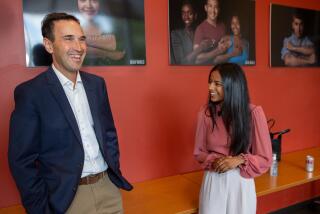Ira Michael Heyman dies at 81; led UC Berkeley, Smithsonian
Ira Michael Heyman, a champion of affirmative action who led UC Berkeley as its chancellor during the 1980s and later became the first non-scientist to lead the Smithsonian Institution, has died. He was 81.
Heyman died at his Berkeley home Saturday after a long battle with emphysema. The Smithsonian and the university announced his death Monday.
During 10 years as UC Berkeley chancellor, Heyman increased minority representation in the student body and on the faculty, efforts that stirred considerable debate and controversy. He was a prolific fundraiser whose tenure brought a substantial rise in private gifts, from $30 million to $100 million. He also strengthened the biological sciences at Berkeley, leading a consolidation of fragmented specialties and upgrading and building laboratories and other facilities.
“Mike Heyman was a great and inspiring leader whose vision helped shape the future of the Berkeley campus,” said university Chancellor Robert Birgeneau in a message to the campus. “Simply, he believed that Berkeley should be second to none, and open to all.”
Heyman’s skill at guiding a complex institution in an often heated political atmosphere led to his selection as the Smithsonian’s 10th secretary, or director, in 1994.
During his five years as chief of the world’s largest museum and research complex, Heyman oversaw creation of the Smithsonian’s first website and an affiliations network that now includes 170 museums across the country. He secured funding to build the National Museum of the American Indian and a major donation for a National Air and Space Museum annex in northern Virginia.
Heyman arrived at the Smithsonian facing controversy over the Air and Space Museum’s planned exhibition of the B-29 Enola Gay that dropped the atomic bomb on Hiroshima. Some historians and veterans groups complained that it was too sympathetic to the Japanese.
Heyman eventually canceled the planned exhibit and replaced it in 1995 with a simple display of the plane without commentary, context or analysis. The revised exhibit also drew fire from critics, who accused him of giving in to pressure.
The controversy led Heyman to draft new guidelines for dealing with controversial subjects and required that top management review any exhibits involving sensitive issues.
“Heyman was unflinchingly optimistic about the Smithsonian’s ability to be a force for knowledge and inspiration in our society,” current Smithsonian Secretary Wayne Clough said in a statement. He said Heyman’s signature program was a celebration of the Smithsonian’s 150th anniversary in 1996 with a major traveling exhibit, “America’s Smithsonian.”
Heyman was born May 30, 1930, in New York City and attended the elite Bronx High School of Science. But the 6-foot-5 Heyman later switched to the Horace Mann School to indulge his passion for basketball and other sports. He earned top academic honors and was elected student body president.
He graduated from Dartmouth College in 1951 before serving as a first lieutenant in the Marine Corps during the Korean War. In 1956, he earned his law degree at Yale, where he was editor of the Yale Law Journal. In 1958 and 1959, he was a law clerk to Chief Justice of the United States Earl Warren.
He joined Berkeley’s law school faculty in 1959 as acting associate professor and became a full professor two years later. He also taught in the city and regional planning department.
During the Free Speech Movement of the 1960s, he chaired the Academic Senate’s Ad Hoc Committee on Student Conduct. That committee produced what became known as the Heyman Report, which was highly critical of the administration’s reaction to and handling of campus demonstrations.
After rising to vice chancellor in 1974, he directed the drafting of Berkeley’s affirmative action plan, which, after much debate and negotiation, became the first such campus plan approved by the federal government.
Named chancellor in 1980, he continued to promote opportunities for minority students and considered the ethnic diversification of the campus his major achievement.
Under his leadership, minority undergraduate enrollment rose from 33.9% to 57.9%. At the same time, SAT scores of incoming freshmen increased.
Minority representation among the faculty also improved, rising from 8.8% to 11.5%.
“Mike was the sparkplug to diversify the campus,” Roderic Park, who was vice chancellor under Heyman, said in a statement Monday. “His goal to accept all qualified underrepresented minorities was met with a lot of resistance. There is nothing harder to change than culture. But Heyman moved the culture at the university. He had a lot of political courage for what he did.”
His efforts to create a more diverse campus brought protests from Asian American and white students, who charged that affirmative action policies were unfairly reducing their chances for admission to the prestigious university. Complaints that the school was trying to limit Asian American enrollment led to investigations by faculty and the state government and resulted in some changes in admission policy. Heyman later apologized to the Asian American community for what he said had been an overly defensive reaction to their allegations.
When he announced that he was stepping down from the chancellorship, he said one of the reasons was weariness with the confrontational politics that come with the job of leading a campus long known as a hotbed of controversy.
He returned to teach law at Berkeley after retiring from the Smithsonian in 1999.
He is survived by his wife, Elizabeth; a son, James Heyman; and three grandchildren. His first wife, Therese Thau Heyman, died in 2004, and a son, Stephen, also died. A memorial service on campus is being planned.
More to Read
Start your day right
Sign up for Essential California for the L.A. Times biggest news, features and recommendations in your inbox six days a week.
You may occasionally receive promotional content from the Los Angeles Times.




















































